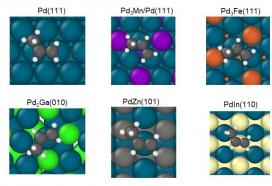Arrangement of Metal Surface Atoms Shown to Shape Catalytic Performance
The physical arrangement of metal atoms on the surfaces of catalysts can change the performance of the catalytic particles, according to research at the Center for Innovative and Strategic Transformation of Alkane Resources (CISTAR), an NSF-funded Engineering Research Center (ERC) based at Purdue University.
CISTAR is investigating several new alloy and metal catalysts, which will operate at the high temperatures necessary for ethane dehydrogenation. The ability of CISTAR researchers to demonstrate the relative performance of different arrangements of metal atoms may point to optimal arrangements to achieve desired catalytic properties, particularly for the conversion of shale gas to chemicals used in industry.
CISTAR experimental and theoretical research teams from Purdue showed that the arrangement of palladium atoms on the surface of nanoparticles of palladium alloys controls the catalytic performance of these particles. The results show that alloys with smaller groups of palladium atoms on the surface more easily convert shale gas to desired chemicals.



